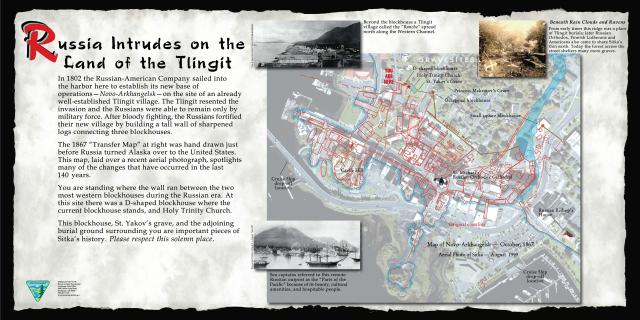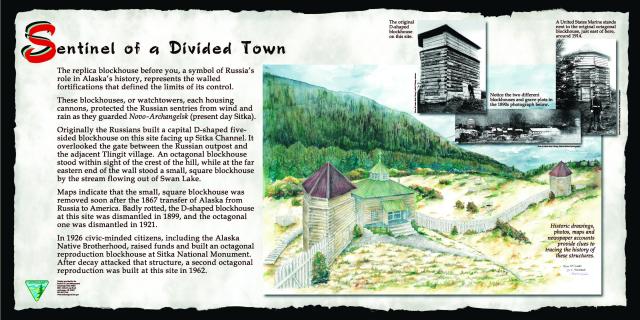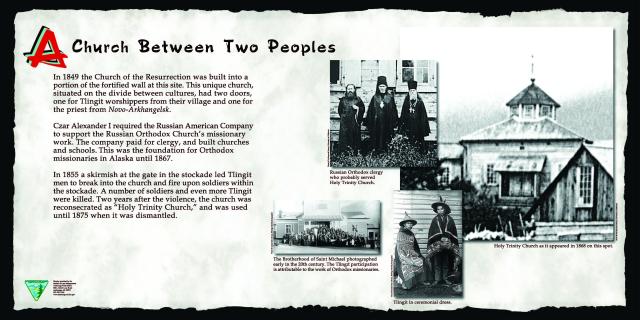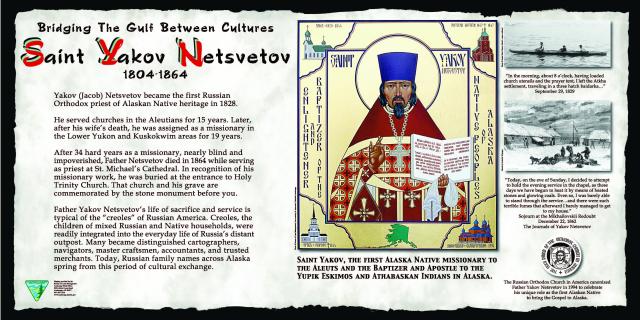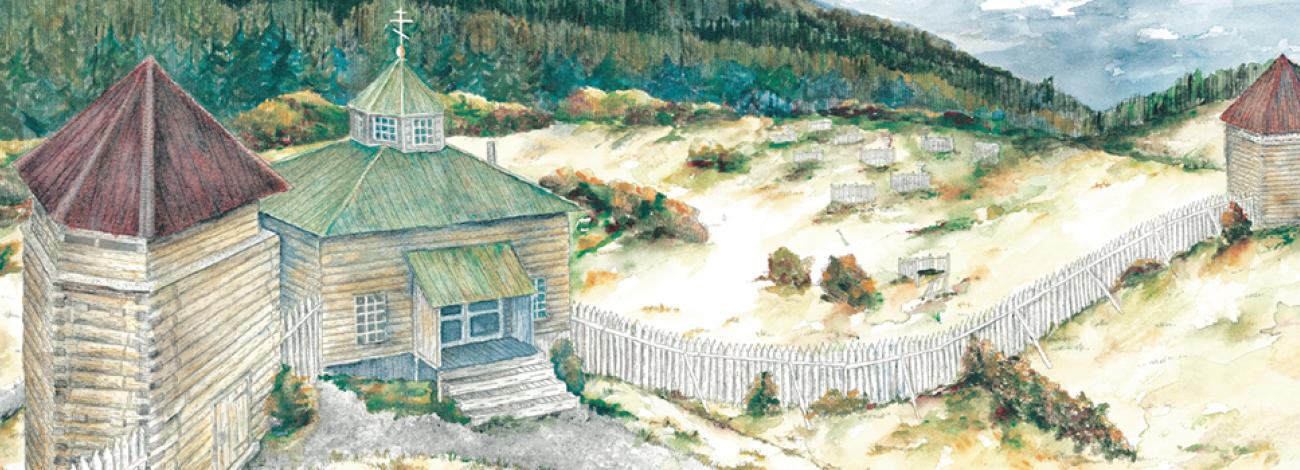
Sitka Blockhouse
The BLM manages the Sitka Blockhouse, an early 1960's replica of a Russian fortification around the town of Sitka, which was once the capital of Russian America. The structure was part of a defensive stockade built around Sitka in the early 1800s. It is located near the Orthodox Church's historic cemetery and is cooperatively managed by the BLM and the National Park Service.
Holy Trinity Church was located close to the blockhouse in the stockade. The church was built in 1849 and consecrated by Bishop Innokentii. This church was built expressly for the local Tlingit community where services could be conducted in the Tlingit language. The church was built right into the stockade surrounding the little Russian town of Novoarkangel’sk (Sitka). The western door of the church opened to the Tlingit village; the eastern doors inside the stockade faced the Russian village. Because relations between the Russians and the Tlingit continued to be tense for decades after their initial conflict, the Russians were in a quandary about Tlingit conversion to the Orthodox Church. On the one hand, the Russians were gratified that so many Tlingit desired to attend church. On the other hand, they were uneasy about allowing up to 200 Tlingit at a time into the stockade to go to services. Holy Trinity Church was built to solve this problem.
Learn more about the history of the capital of Russian Alaska, on the Sitka National Historic Park website.
For those who are interested in the history of the Blockhouse the BLM installed four panels at the site. They can also be viewed below:
- Russia Intrudes on the Land of the Tlingit
Russia Intrudes on the Land of the Tlingit Panel (The following text appears on the above panel)
In 1802 the Russian-American Company sailed into the harbor here to establish its new base of operations - Novo-Arkhangel'sk - on the site of an already well-established Tlingit village. The Tlingit resented the invasion and the Russians were able to remain only by military force. After bloody fighting, the Russians fortified their new village by building a tall wall of sharpened logs connecting three blockhouses.
The 1867 ''Transfer Map'' at right was hand drawn just before Russia turned Alaska over to the United States. This map, laid over a recent aerial photograph, spotlights many of the changes that have occurred in the last 140 years.
You are standing where the wall ran between the two most western blockhouses during the Russian era. At this site there was a D-shaped blockhouse where the current blockhouse stands, and Holy Trinity Church. This blockhouse, St. Yakov' s grave, and the adjoining burial ground surrounding you are important pieces of Sitka' s history. Please respect this solemn place.
- Sentinel of a Divided Town
Sentinel of a Divided Town Panel (The following text appears on the above panel)
The replica blockhouse before you, a symbol of Russia's role in Alaska's history, represents the walled fortifications that defined the limits of its control. These blockhouses, or watchtowers, each housing cannons, protected the Russian sentries from wind and rain as they guarded Novo-Archangelsk (present day Sitka).
Originally the Russians built a capital D-shaped five-sided blockhouse on this site facing up Sitka Channel. It overlooked the gate between the Russian outpost and the adjacent Tlingit village. An octagonal blockhouse stood within sight of the crest of the hill, while at the far eastern end of the wall stood a small, square blockhouse by the stream flowing out of Swan Lake.
Maps indicate that the small, square blockhouse was removed soon after the 1867 transfer of Alaska from Russia to America. Badly rotted, the D-shaped blockhouse at this site was dismantled in 1899, and the octagonal one was dismantled in 1921.
In 1926 civic-minded citizens, including the Alaska Native Brotherhood, raised funds and built an octagonal reproduction blockhouse at Sitka National Monument. After decay attacked that structure, a second octagonal reproduction was built at this site in 1962.
- A Church Between Two Peoples
A Church Between Two Peoples Panel (The following text appears on the above panel)
In 1849 the Church of the Resurrection was built into a portion of the fortified wall at this site. This unique church, on the divide between cultures, had two doors, one for Tlingit worshippers from their village and one for the priest from Novo-Arkhangelsk.
Czar Alexander I required the Russian American Company to support the Russian Orthodox Church's missionary work. The company paid for clergy and built churches and schools. This was the foundation for Orthodox missionaries in Alaska until 1867.
In 1855 a skirmish at the gate in the stockade led Tlingit men to break into the church and fire upon soldiers within the stockade. A number of soldiers and even more Tlingit were killed. Two years after the violence, the church was reconsecrated as ''Holy Trinity Church," and was used until 1875 when it was dismantled.
- Bridging the Gulf between Cultures: Saint Yakov Netsvetov 1804-1864
Bridging the Gulf between Cultures: Saint Yakov Netsvetov 1804-1864 Panel (The following text appears on the above panel)
Yakov (Jacob) Netsvetov became the first Russian Orthodox priest of Alaskan Native heritage in 1828.
He served churches in the Aleutians for 15 years. Later, after his wife's death, he was assigned as a missionary in the Lower Yukon and Kuskokwim areas for 19 years.
After 34 hard years as a missionary, nearly blind and impoverished, Father Netsvetov died in 1864 while serving as priest at St. Michael's Cathedral. In recognition of his missionary work, he was buried at the entrance to Holy Trinity Church. That church and his grave are commemorated by the stone monument before you.
Father Yakov Netsvetov's life of sacrifice and service is typical of the ''creoles'' of Russian America. Creoles, the children of mixed Russian and Native households, were readily integrated into the everyday life of Russia's distant outpost. Many became distinguished cartographers, navigators, master craftsmen, accountants, and trusted merchants. Today, Russian family names across Alaska spring from this period of cultural exchange.

